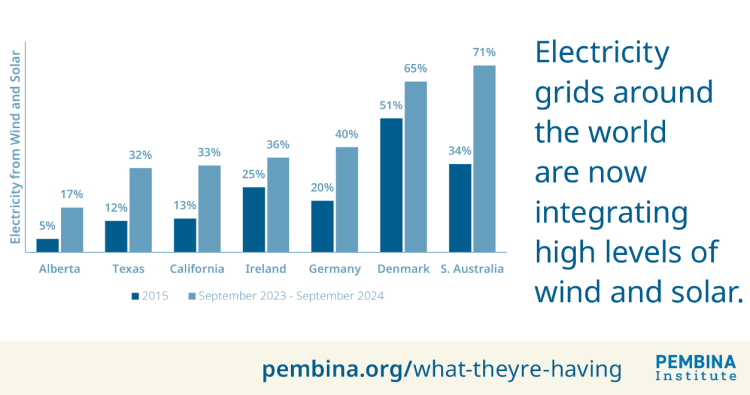Saturday, July 5, 2025
A new report from the Pembina Institute provides insight into the benefits of integrating high levels of renewable energy on grids, highlighting the value of prioritizing grid flexibility using interconnections and innovation. The report, entitled “I’ll Have What They’re Having,” shows it is possible for grids to operate reliably and affordably with high levels of renewables. It also indicates that Canada is falling behind and risks missing out on the opportunity to be a world leader in renewable electricity.
Alberta has seen a sharp rise in emergency grid alerts in the past few years, mostly caused by unexpected outages of large gas plants during high demand periods when it was known that renewables wouldn’t be available. With a modern and reliable grid, emergency alerts should not be this common. For example, in previous years, Californians were asked to conserve electricity during heatwaves because their grid was unable to keep up with demand. But thanks to new clean energy and storage resources added in the past two years, alongside improved coordination between the system operator and government, California’s grid weathered record-breaking demand while also exporting electricity to support its neighbours.
“In this new and emerging Age of Electricity,’ Canada must accelerate its deployment of low-cost wind and solar, to meet accelerating demand growth in an affordable and reliable manner,” said Will Noel, an analyst with the Pembina Institute, a leading think tank. “Sunny and windy Alberta is especially well positioned, but risks falling behind.”
Pembina’s analysis demonstrates that operating a modern grid with high levels of renewable resources helps provide affordable and reliable power for homes and businesses.

Key takeaways
- Rooftop solar can play a significant role in reducing electricity sector emissions while minimizing transmission infrastructure costs. In South Australia, rooftop solar panels have met nearly 20 per cent of the state’s demand so far in 2024.
- Wind and solar energy are complementary in the course of a day and between seasons. In all the studied jurisdictions, wind energy is more prominent at night and in winters, while solar resources are more important during the day and in summers.
- Only four per cent of Alberta’s total generating capacity is covered by energy storage, interties and demand-response compared to 11 per cent in Texas and 46 per cent in Denmark. Alberta needs to make improvements toward a more flexible and resilient grid.
To read the complete report, click here: I’ll Have What They’re Having: Lessons learned from six jurisdictions leading in wind and solar deployment.











